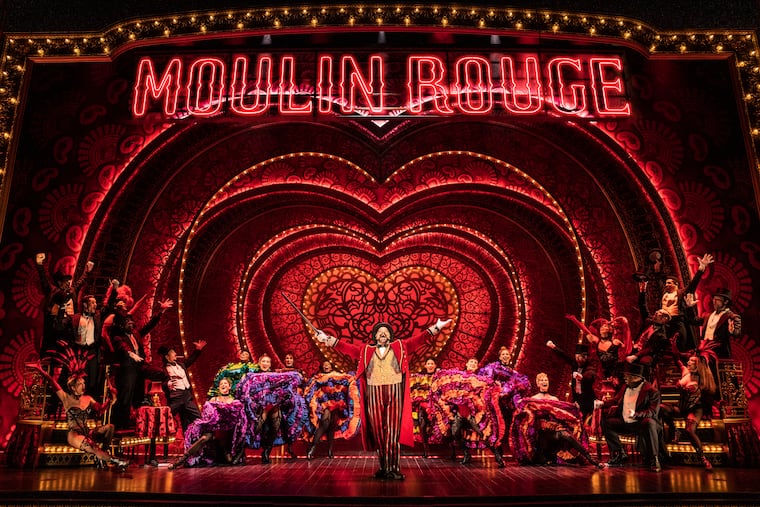Four can’t miss details from ‘Moulin Rouge! The Musical’ at the Academy of Music
Lace, lights, and lushness bring the bohemian high energy of the Baz Luhrmann film to Academy of Music.

The extravagant glitz and glam of Moulin Rouge! The Musical — which won 10 Tony Awards — has come to the Kimmel Cultural Campus’ Academy of Music, through July 23.
Set in the Montmartre Quarter of Paris at the turn of the 20th century, the musical largely follows the same beat as the 2001 film Moulin Rouge!, directed by Baz Luhrmann.
The Broadway rendition, like the film, is a jukebox musical inspired by the centuries-old cabaret and vaudeville theater styles.
The film’s plot, partly drawn from Giacomo Puccini’s opera La bohème, departs only slightly to include some contemporary updates.
Expect flowy choreography, iconic songs, lavish costumes, and extremely glamorous people on stage, as you follow the story of a young composer named Christian (actor John Cardoza) who arrives in Paris from Lima, Ohio.
He meets bohemians Toulouse-Lautrec and Santiago and falls in love with Satine (Courtney Reed), a cabaret actor and star of the beloved nightclub Moulin Rouge.
Here is how the world of Moulin Rouge! The Musical and 1899 Paris is being summoned to Philadelphia under the directorial eyes of Tony Award-winner Alex Timbers,costume designer Catherine Zuber, and set designer Derek McLane.
Lights, lights, lights, and more lights
McLane started out as the musical’s set designer in June 2017. Since then, he has worked on recreating elements from the cabaret aesthetic of the 2001 film and fusing them within the world crafted by playwright John Logan.
Translating Luhrmann’s high-energy, quick-cut directorial style to the stage wasn’t easy. McLane worked with lighting designer Justin Townsend and added radiant lightbulbs and gaudy fixtures to the set, to help bring that sense of glam to the Broadway musical.
“We made as many things as possible on the set light up,” he said. “It makes it look like the scenery is moving to the beat of the music, which is incredibly fast. The scenery is actually sitting still on stage, but that kind of frenetic cueing captures some of the energy of the movie in that way.”
Couture from late 19th-century Paris meets high fashion from the early 2010s
Zuber was inspired by the use of satin, silk, and lace fabrics, and extravagant adornments seen in the Moulin Rouge! film, which won Academy Awards for best production design and best costume design. She took those looks and combined them with runway trends from the 1990s and early 2010s.
Zuber took the bright cancan dresses and lush corsets from the 19th-century Parisian dances and added elements from contemporary high-fashion brands.
“There was an amazing movement in high couture [in the 1990s and 2010s] that was quite theatrical, and there was so much inspiration based on what was happening on the runways,” said Zuber, who has won eight Tony Awards for design, including for this show.
Zuber was particularly inspired by Christian Dior’s 2005 and Alexander McQueen’s 2017 fall collections for the character’s lingerie and lace pieces.
A ‘real’ depiction of late 19th-century Paris
McLane said the fantastical elements of Moulin Rouge! The Musical made it one of his most ambitious projects. To recreate late 19th-century Paris for the Broadway stage, he combined memories of his childhood growing up in India and traveling to Morocco, with the history of Paris.
Outside of the Moulin Rouge nightclub set, there is a mix of traditional French structures and other cultural elements that mirrored the Bohemian influence of the day.
“The Paris of 1899 had all of these interesting Asian and Middle Eastern influences,” he said.
The Parisian backdrop is most prominent and muted in color when depicting the Montmartre neighborhood. Large, grayscale buildings are visible in the foreground, which then tail off into smaller models as they blend in with winding streets in the background.
Christian and Henri de Toulouse-Lautrec’s rag-filled garret shows the lively but poverty-stricken conditions many artists were living under at the time.
After researching old Parisian courtesan quarters, McLane filled Satine’s place with layered carpets, decorative Moroccan panels, and glimmering fabrics that bring a sense of regality to the dancer’s home.
He even included a heart-shaped window as a homage to Luhrmann’s film.
Practicality with a zing
“We wanted to keep the aesthetics up to the same design power that the film had, but because it’s the stage version, there are different considerations,” Zuber said.
Her elaborate costumes combine design with practicality. The dancers can move freely and wear dance shoes under their costumes. Zuber also added small panels to the actors’ corsets to allow more flexibility.
“Since the choreography is so intense, I needed to strip away the garments as much as possible so audiences could see the body movement,” Zuber said.
Most theater-goers, Zuber said, scan performers from head to toe, so each costume is consistently extravagant. Instead of drowning ensemble characters in muted tones, she made the lead characters’ costumes even brighter.
“We all worked very hard to bring it to life and have it be a successful show,” she said.
It surely will be.
Moulin Rouge! The Musical continues through July 23 at the Academy of Music, 240 S. Broad St. Tickets start at $20. For information: kimmelculturalcampus.org.